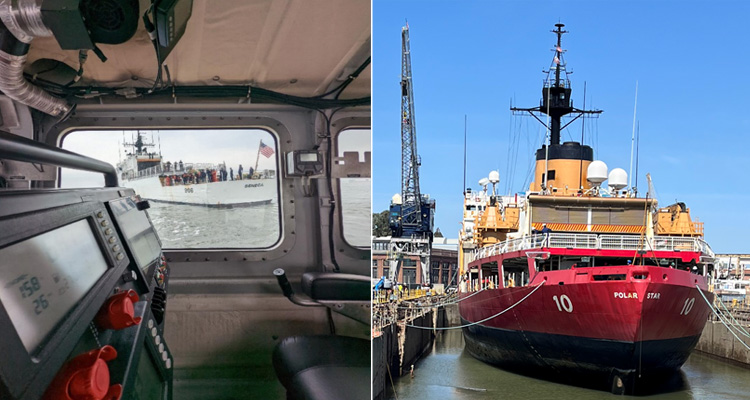April 21, 2022 —

Left: The Coast Guard Cutter Seneca, as seen from inside a Coast Guard boat, departs Coast Guard Yard in Baltimore April 4, 2022, after service life extension program work was completed. Right: Coast Guard Cutter Polar Star arrives at Mare Island Dry Dock LLC in Vallejo, California, April 8. U.S. Coast Guard photos.
Two Coast Guard service life extension programs (SLEP) reached milestones in early April – prototype work was completed on a 270-foot medium endurance cutter (WMEC) and Coast Guard Cutter Polar Star commenced the second phase of its SLEP work.
SLEPs address specific systems and major maintenance to extend the service life of the vessel to meet cost, schedule and performance requirements. They are part of the In-Service Vessel Sustainment Program, which conducts strategic major maintenance and recapitalization as vessels age and critical systems become obsolete, improving the reliability of Coast Guard vessels, helping control maintenance costs and increasing time spent underway.
For the WMEC SLEP, Coast Guard Cutter Seneca recently departed Coast Guard Yard April 4 for its homeport in Portsmouth, Virginia. Seneca served as a prototype for the SLEP work on the WMECs, which is a renewal of several mission-critical systems including electrical updates with new generators, switchboards and Coast Guard machinery control system software updates.
“This wraps up a successful nine-month project at Coast Guard Yard that began in July 2021 totaling over $6.4 million,” said Lt. Charles Lortz, the Project Residence Office Baltimore 270-foot WMEC SLEP section chief. “Beyond the difficulties inherent to a prototype project, the Seneca project followed an expedited planning process to more quickly deliver a more capable asset to the fleet. It was certainly noted, by all involved, that this project was charting new territory.”
Coast Guard Cutter Harriet Lane arrived at Coast Guard Yard March 28 and will undergo prototype refinements. Six more of the 13 in-service WMECs will undergo SLEP work, with production work starting in 2023. The WMEC SLEP will sustain capabilities to meet mission needs until they are replaced by offshore patrol cutters.
As Seneca was heading to its homeport, Polar Star transited from the San Francisco Bay to Mare Island Dry Dock LLC in Vallejo, California. On April 8, it commenced the second phase of SLEP work items and recurring maintenance, which is taking place over a five-year, annually phased production schedule that runs through 2025. During the second phase, Polar Star SLEP will recapitalize two engineering control systems: one will operate and control the cutter’s 75,000 shaft horsepower gas turbines and auxiliary systems while the other control system is dedicated to the diesel electric propulsion plant. When completed, Polar Star’s SLEP will have replaced a number of major systems and extended the service life of the Coast Guard’s only operational heavy icebreaker.
The Coast Guard is also investing in a new fleet of polar security cutters (PSC) that will sustain the service’s capabilities to meet mission needs in both the Arctic and Antarctic regions. The first PSC is on contract for delivery in 2025. Polar Star will stay in service until the second PSC is operational.
For more information: In-Service Vessel Sustainment Program page